Description
A unique how-to guide for spine surgeons on state-of-the-art computer-assisted navigation and robotic surgery
techniques
The past decade has seen major advances in image-guided spine surgery techniques, with robotically assisted
approaches emerging in the last five years. While early adopters of this technology paved the way for more
widespread use of navigated and robotic systems, barriers still exist. Navigation and Robotics in Spine Surgery
by master spine surgeon Alexander Vaccaro and esteemed co-editors Jaykar Panchmatia, I. David Kaye, and Srinivas
Prasad addresses existing issues such as the perception of increased upfront costs, intrusion on current workflow,
and a lack of understanding about the potential ways these technologies can enhance the surgical experience and
improve patient outcomes.
더보기
Organized into six sections, the book starts with evidence-based fundamentals of navigated spine surgery and
robotics including discussion of instrumentation and mechanics. Sections 2-5 serve as a surgical handbook for
spine surgeons who wish to introduce these technologies into practice or augment their current repertoire with more
complex techniques. Topics range from more routine procedures such as navigated and robotic minimally invasive TLIF
to complex approaches like intraoperative ultrasound guided intradural spinal tumor resection. The final section
looks at future directions and potential new applications for these technologies.
Key Highlights
invaluable tricks of the trade
radiation exposure and minimization strategies
learned from other industries
Part I Introduction to Navigation and Robotics
1 Principles of Navigated Pedicle Screw Placement
2 Three-Dimensional Computer-Assisted Navigation Platforms
3 Intraoperative Ultrasound in Spine Surgery: A Versatile and Useful Adjunct
더보기
4 Magnetic Resonance Imaging–Based Navigation
5 Shared Control Robotics
6 Telesurgical Robots
7 Supervisory-Controlled Robotics
8 Radiation Exposure and Navigated Spinal Surgery
Part II Techniques for Navigation-Assisted Spine Surgery
9 Outcomes in Navigated Spinal Surgery
10 Navigated Subaxial Cervical Spine Pedicle Screw Instrumentation
11 Navigated Anterior Transoral Surgery for C1 and C2 Pathologies
더보기
12 Navigated Posterior Correction of Pediatric Scoliosis
13 Navigated Posterior Instrumentation of the Arthrodesed Spine
14 Navigated Minimally Invasive Transforaminal Lumbar Interbody Fusion
15 Robotic Instrumentation for Lumbosacral Spondylolisthesis
16 The Role of Navigation in the Resection of Primary Spinal Tumor
17 Surgical Management of Thoracolumbar Spinal Metastases Using Navigation
18 Navigated Pelvic Fixation
19 Navigated Sacroiliac Joint Fusion
20 Navigation Balloon Kyphoplasty
Part III Techniques for Robotic-Assisted Spine Surgery
21 Outcomes in Robotic Spinal Surgery
22 Robotic Subaxial Cervical Spine Pedicle Screw Instrumentation
23 Navigated and Robotic Anterior Odontoid Peg Fracture Fixation
더보기
24 Navigated and Robotic Posterior Atlantoaxial Fusion
25 Robotic Posterior Thoracic Pedicle Screw Placement
26 Robotic Minimally Invasive Transforaminal Lumbar Interbody Fusion
27 Robotic Anterior Lumbar Interbody Fusion
Part IV Techniques Using Alternative Modalities for Complex Spine Pathology
28 Intraoperative Ultrasound-Guided Intradural Tumor Resection
29 Stereotactic Radiosurgery for Treatment of Primary and Metastatic Spinal Tumors
Part V Easing the Transition to Technological Adoption
30 Operating Room Design and Efficiency
31 Mounting the Learning Curve with New Technologies
Part VI Future Directions
32 Artificial Intelligence
33 What We Can Learn from Other Industries
34 Future Growth in Navigated and Robotic Spinal Surgery
Index


